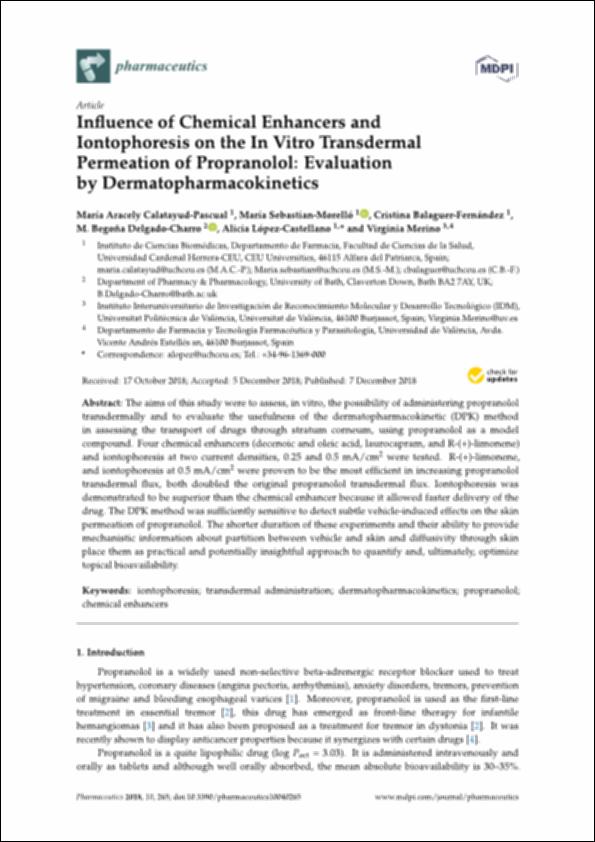Por favor, use este identificador para citar o enlazar este ítem:
http://hdl.handle.net/10637/10237Influence of chemical enhancers and iontophoresis on the in vitro transdermal permeation of Propranolol : evaluation by dermatopharmacokinetics
| Título : | Influence of chemical enhancers and iontophoresis on the in vitro transdermal permeation of Propranolol : evaluation by dermatopharmacokinetics |
| Autor : | Calatayud Pascual, María Aracely Sebastián Morelló, María Balaguer Fernández, Cristina Delgado Charro, M. Begoña López Castellano, Alicia Cristina Merino Sanjuán, Virginia |
| Materias: | Medicamentos - Administración.; Propanol - Farmacocinética.; Propanol - Pharmacokinetics.; Absorción cutánea.; Ionization.; Ionización.; Propanol - Uso terapéutico.; Propanol - Therapeutic use.; Drugs - Administration.; Skin absorption. |
| Editorial : | MDPI |
| Citación : | Calatayud Pascual, MA., Sebastián Morelló, M., Balaguer Fernández, C., Delgado Charro, MB., López Castellano, A. & Merino, V. (2018). Influence of chemical enhancers and iontophoresis on the in vitro transdermal permeation of Propranolol : evaluation by dermatopharmacokinetics. Pharmaceutics, vol. 10, n. 4, art. 265. DOI: https://doi.org/10.3390/pharmaceutics10040265 |
| Resumen : | The aims of this study were to assess, in vitro, the possibility of administering propranolol transdermally and to evaluate the usefulness of the dermatopharmacokinetic (DPK) method in assessing the transport of drugs through stratum corneum, using propranolol as a model compound. Four chemical enhancers (decenoic and oleic acid, laurocapram, and R-(+)-limonene) and iontophoresis at two current densities, 0.25 and 0.5 mA/cm2 were tested. R-(+)-limonene, and iontophoresis at 0.5 mA/cm2 were proven to be the most efficient in increasing propranolol transdermal flux, both doubled the original propranolol transdermal flux. Iontophoresis was demonstrated to be superior than the chemical enhancer because it allowed faster delivery of the drug. The DPK method was sufficiently sensitive to detect subtle vehicle-induced effects on the skin permeation of propranolol. The shorter duration of these experiments and their ability to provide mechanistic information about partition between vehicle and skin and diffusivity through skin place them as practical and potentially insightful approach to quantify and, ultimately, optimize topical bioavailability. |
| Descripción : | Este artículo se encuentra disponible en la página web de la revista en la siguiente URL: https://www.mdpi.com/1999-4923/10/4/265 En este artículo científico también participan los siguientes autores: María Sebastian Morelló, Cristina Balaguer Fernández, M. Begoña Delgado Charro, Alicia López Castellano and Virginia Merino. |
| URI : | http://hdl.handle.net/10637/10237 |
| Derechos: | http://creativecommons.org/licenses/by/4.0/deed.es |
| ISSN : | 1999-4923. |
| Fecha de publicación : | 7-dic-2018 |
| Centro : | Universidad Cardenal Herrera-CEU |
| Aparece en las colecciones: | Dpto. Farmacia |
Los ítems de DSpace están protegidos por copyright, con todos los derechos reservados, a menos que se indique lo contrario.


